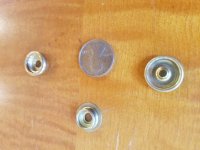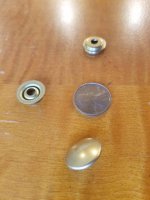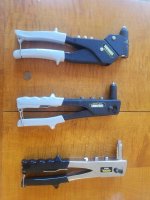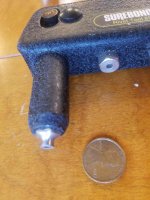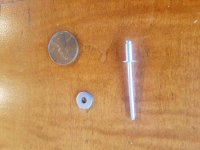G
Guest
Guest
The stern spray cover was easier than the bow, largely because I already had a template. There is something to be said for the ease of making a partial or even two piece cover for a symmetrical canoe and using the same size template/cover for bow and stern*; making the Visqueen template with all those weirdo end angles and ears takes longer than cutting the fabric and ironing over the hems.
*Or not. It is just possible, I suppose, that when I first reguwaled the Independence that I made it just a wee bit Swede-form along the stern sheerline. The duplicate cover fits securely, but has a bit more pucker on the below-outwale overlap. Still easier than making a new template for a teeny bit of difference.
Also, when seating the button caps on the cover be aware of any floatation tank interference. Those snaps at the stern float tank end were close.
I did not leave the shipped-folded red Oxford cloth rolled for long, just a couple days, but even that was enough to take the creases out. Roll ‘em if you got ‘em. Visqueen template material too.
Laying the fabric out on the table I quickly realized something; the red Oxford cloth I had leftover and used to make the bow cover was not actually 2 yards in length, but considerably less (I never actually measured that leftover cloth.) Had it been 2 yards I could have made both covers from that quantity of material.
 PC030027 by Mike McCrea, on Flickr
PC030027 by Mike McCrea, on Flickr
Same DIY routine as before, no need to yaddayaddayadda repeat all those words.
I made the stern cover paddle pocket smaller, for a reason. A frugal reason; I had a \_/ piece of leftover red Oxford cloth and didn’t want to cut that odd shape from the larger 2-yard remains, which, as-is, would be enough to make another partial cover.
Because there is no thwart with webbing loops on machine screw ends below the stern cover, as on the bow section, I added two mini SS D-rings per side. Between the webbing loops on the machine screw ends, the mini D-rings backing up the spray cover studs and the Northwater double D-rings G/flexed to the floor that combination provides ample tie down points, I’m not planning to tie in floatation bags and run whitewater with the FreeFIRE, someone already did that.
All dressed up and nowhere to go.
 PC050048 by Mike McCrea, on Flickr
PC050048 by Mike McCrea, on Flickr
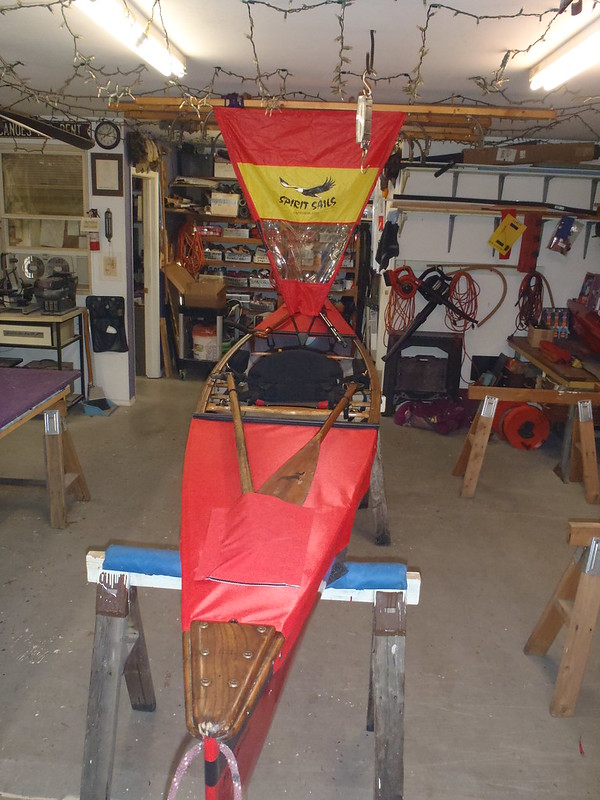 PC050049 by Mike McCrea, on Flickr
PC050049 by Mike McCrea, on Flickr
 PC050051 by Mike McCrea, on Flickr
PC050051 by Mike McCrea, on Flickr
Actually I do have somewhere in mind to go, couple places in fact, but in a few days, after the Dual Lock acrylic adhesive on the hull pieces has had time to fully cure, I want to remove the covers and paint a bead of black pigmented G/flex around sides and top the Dual Lock on the stern and, hull flipped over, the remaining bottom edge both bow and stern. Belt and suspenders, in for a penny and all that.
I am jonsing to paddle the refurbished FreeFIRE (nee Independence). I remember the Indy as being speedy for a 6.48 length-to-waterline canoe, and surprisingly stable for a canoe with 28.5” gunwales.
I know it will now be more comfortable, more efficient in the wind, better appointed and, I hope, a mystery to some fellow canoehead who sees it and wonders “What boat is that?”
*Or not. It is just possible, I suppose, that when I first reguwaled the Independence that I made it just a wee bit Swede-form along the stern sheerline. The duplicate cover fits securely, but has a bit more pucker on the below-outwale overlap. Still easier than making a new template for a teeny bit of difference.
Also, when seating the button caps on the cover be aware of any floatation tank interference. Those snaps at the stern float tank end were close.
I did not leave the shipped-folded red Oxford cloth rolled for long, just a couple days, but even that was enough to take the creases out. Roll ‘em if you got ‘em. Visqueen template material too.
Laying the fabric out on the table I quickly realized something; the red Oxford cloth I had leftover and used to make the bow cover was not actually 2 yards in length, but considerably less (I never actually measured that leftover cloth.) Had it been 2 yards I could have made both covers from that quantity of material.
 PC030027 by Mike McCrea, on Flickr
PC030027 by Mike McCrea, on FlickrSame DIY routine as before, no need to yaddayaddayadda repeat all those words.
I made the stern cover paddle pocket smaller, for a reason. A frugal reason; I had a \_/ piece of leftover red Oxford cloth and didn’t want to cut that odd shape from the larger 2-yard remains, which, as-is, would be enough to make another partial cover.
Because there is no thwart with webbing loops on machine screw ends below the stern cover, as on the bow section, I added two mini SS D-rings per side. Between the webbing loops on the machine screw ends, the mini D-rings backing up the spray cover studs and the Northwater double D-rings G/flexed to the floor that combination provides ample tie down points, I’m not planning to tie in floatation bags and run whitewater with the FreeFIRE, someone already did that.
All dressed up and nowhere to go.
 PC050048 by Mike McCrea, on Flickr
PC050048 by Mike McCrea, on Flickr PC050049 by Mike McCrea, on Flickr
PC050049 by Mike McCrea, on Flickr PC050051 by Mike McCrea, on Flickr
PC050051 by Mike McCrea, on FlickrActually I do have somewhere in mind to go, couple places in fact, but in a few days, after the Dual Lock acrylic adhesive on the hull pieces has had time to fully cure, I want to remove the covers and paint a bead of black pigmented G/flex around sides and top the Dual Lock on the stern and, hull flipped over, the remaining bottom edge both bow and stern. Belt and suspenders, in for a penny and all that.
I am jonsing to paddle the refurbished FreeFIRE (nee Independence). I remember the Indy as being speedy for a 6.48 length-to-waterline canoe, and surprisingly stable for a canoe with 28.5” gunwales.
I know it will now be more comfortable, more efficient in the wind, better appointed and, I hope, a mystery to some fellow canoehead who sees it and wonders “What boat is that?”

